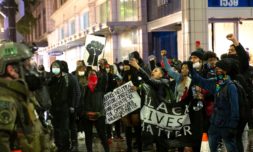JK Rowling taught most of the world a new acronym this week, and not really in a good way.
There are over one million words contained within the Harry Potter series in total, though it seems JK Rowling has managed to make just as big a splash in under 280 characters. A recent tweet by the world-famous author has been trending for days now, making the internet aware of a sad reality the LGBT+ community has long been cognisant of: JK Rowling is a TERF.
As JK finds herself mercilessly crushed by the combine harvester of public disapproval that she willingly jumped in front of, she’s given mainstream popular culture an opportunity to dissect a dialogue that has been relegated to the fringes of gendered discourse for too long now: the exclusion of trans women from all-female spaces.

So, what is a TERF?
The acronym stands for ‘transgender exclusionary radical feminist’. According to Viv Smythe – the cis woman who is credited with coining the term but insists it was used in the trans community long before her – a TERF is a certain sub-section of ‘radfems’ or radical feminists who do not include trans women in their consideration of womanhood.
TERF ideology can range from overt denials that trans women are who they say they are, to covert microaggressions, like suggesting that certain female only spaces like rape crisis centres should exclude trans women. The softer forms of TERFism are, of course, born from the same prejudice as the hard-line views: the idea that trans women aren’t ‘real’ women.
Rowling was clearly tapping into this hateful ideology when, on Saturday, she implied that only women menstruate.
‘People who menstruate.’ I’m sure there used to be a word for those people. Someone help me out. Wumben? Wimpund? Woomud?
Opinion: Creating a more equal post-COVID-19 world for people who menstruate https://t.co/cVpZxG7gaA
— J.K. Rowling (@jk_rowling) June 6, 2020
This, of course, drew the ire of the trans community and their many allies, as well as anyone with a basic understanding of biology and how the law currently pertains to biological sex (read: most people). Her statement excludes trans women as well as the intersex and non-binary community, and essentially relegates gender definition to bodily functions – the exact pseudo-scientific, transphobic dogma that equality narratives have been fighting against for years now.
As you can see, Twitter took aim.
Not all cisgender women menstruate but they are still women, I don’t want to be reduced to my biological functions, not all people who menstruate are women, this is a really abhorrent thing to focus on when the rest of the world is fighting for racial equality. https://t.co/ynP9kFSPIx
— Amy Jones (@jimsyjampots) June 7, 2020
As a physician, I want people to know that sex exists on a bimodal biological spectrum just like gender exists on a bimodal sociological spectrum. While most identify as either female or male, there are intersex and trans individuals whose identities are just as valid and real.
— Eugene Gu, MD (@eugenegu) June 6, 2020
Rowling went on to respond by saying ‘I respect every trans person’s right to live any way that feels authentic and comfortable to them. I’d march with you if you were discriminated against on the basis of being trans.’ As pointed out by many, the trans community is absolutely and repeatedly discriminated against, and Rowling has not been peeped marching.
https://twitter.com/taytaycrews/status/1269409530053443585?ref_src=twsrc%5Etfw%7Ctwcamp%5Etweetembed%7Ctwterm%5E1269409530053443585&ref_url=https%3A%2F%2Fwww.teenvogue.com%2Fstory%2Fjk-rowling-criticized-anti-trans-language-tweets
The statements were considered particularly odious given that Rowling chose to champion them in the midst of worldwide protests against racial inequality – an issue that many were hoping Rowling would take a stance on given her similarly sketchy history with race narratives. Queer Eye‘s Jonathan Van Ness and Halsey weighed in.
Trans women are women. Trans Black people & trans non-Black people are discriminated against every single day. They’re dying. We’re fighting for Black people & trans people and you’re doing this? https://t.co/2l5PHDCpKD
— Jonathan Van Ness (@jvn) June 7, 2020
Imagine writing a generation defining series about a youth uprisal that defeats a tyrannical monster motivated by the preservation of “pure blood” and looking at THIS time in the world and going “hmm…yep. I’m gonna invalidate trans people.”
— h (@halsey) June 7, 2020
Rowling’s Tweets have gained international media attention, but for many members of the LGBT+ community, they come as no surprise.
Rowling ‘outed’ herself as a TERF last year, when she lent her support to Maya Forstater, a woman fired from her job after posting openly transphobic Tweets championing such enlightened views as ‘men cannot change into women’. The hashtag #IStandWithMaya was briefly trending. Rowling joined in.
Dress however you please.
Call yourself whatever you like.
Sleep with any consenting adult who’ll have you.
Live your best life in peace and security.
But force women out of their jobs for stating that sex is real? #IStandWithMaya #ThisIsNotADrill— J.K. Rowling (@jk_rowling) December 19, 2019




















